Exchanging Ideas, Sharing Resources: University, community benefit from interactions, ‘circulation of knowledge’
The culture of community outreach at the University may occasionally be obscured by mountains of books or dimmed in the light of Nobel prizes, but it flows from the research conducted here as well as the values at Chicago’s core. Outreach is an increasingly prominent part of University life, and in the past decade it has reached the greatest level in the University’s history.
This story provides a glimpse of the breadth, commitment and energy of the University’s reach into the broader community. While this story provides a big picture, it is not the complete picture. What these examples show is that individually and collectively, members of the University community are vigorously building new relationships with the community.
“The pursuit of knowledge is our first mission, and it is its own reward,” said President Randel. “But knowledge and the power to create it bring with them responsibilities, and those responsibilities extend to the neighborhoods and the great city in which we live. That those responsibilities are taken seriously is proved every day through the voluntary work of our students, our faculty and our staff. Their service to local schools, social agencies, relief groups and individuals in need is a vital complement to the life of the mind, and it enriches our community as much as it benefits those we assist.”
Duel Richardson has had the opportunity to get to know many of these outreach projects from their inception. Richardson, Director of Neighborhood Relations and Education for the Office of Community and Government Affairs, believes the best way to understand Chicago’s outreach programs is to look at how they permeate the University’s structure. Programs spring from all three basic levels of the University—administration, faculty and students—and they are administered through most, if not all, of the divisions and professional schools across campus.
The heart and soul of outreach
The center of the University’s developing culture of service is the University Community Service Center, created in 1992 as a small student-run organization, and then established as the Office of University Community Service in 1996. The center serves over 2,000 students, faculty and staff a year.
“A decade ago, most people in the University community had a very limited vision of what volunteerism could be,” said Pamela Bozeman-Evans, Director of the UCSC and Associate Dean of Students in the University. “But now the University body recognizes the breadth and depth of service engagement, including volunteerism, not-for-profit employment, educational programming and service learning in organizations across the city of Chicago.”
From summer internships at not-for-profit and public service organizations in Chicago’s Loop to Senior Lawn Care and Garden projects in Woodlawn, the UCSC, housed in the ground floor of the parking structure at 5525 S. Ellis Ave., links students, staff and faculty to hundreds of meaningful service opportunities.
Here is a short list of some of the center’s programs. For more information about these or other programs, visit the UCSC online at http://communityservice.uchicago.edu or call (773) 753-GIVE.
An intensive, 11-week paid internship program sponsored by the College for Chicago undergraduate and graduate students, the Summer Links Internship Program (http://chronicle.uchicago.edu/010712/summer-links.shtml) is dedicated to community building, public service and social change. More than 100 college and graduate students apply for 30 slots each year. The program matches students with not-for-profit and public service organizations that provide substantive internships. The program also provides weekly trainings and workshops to help them become effective community leaders.
Each year during orientation week, UCSC coordinates the Commitment to Community program with first-year students in the College. Students are introduced to diverse Chicago communities through one-day service projects that are followed by a reflection session led by a guest speaker. “This is an important way to introduce first-year students to their new community home,” said Bozeman-Evans. “It is all too easy for students to become so immersed in classes that they forget to explore one of the most dynamic and diverse cities in the world. In the spirit of another famous quote, community service is the tuition we pay for the valuable lessons of community educators.”
Days of Service provide members of the University community with an opportunity to participate in a one-day service project with a variety of partner agencies, ending with a reflection session led by a special guest. Once or twice each academic quarter, Days of Service focus on challenging social issues, hunger, homelessness, environmental pollution, and community arts and culture.
UCSC is entering its second year of a four-year pilot program called Community Service Leadership Training Corps, which receives funding from the University Women’s Board. “CSLTC provides tools to train future community leaders, emphasizes cultural competency, and promotes a four-year commitment through service, research and internships,” said Bozeman-Evans. “Ultimately, the goal of CSLTC is to connect the academy to the community through civic-minded scholarship.”
Participants meet a minimum of four times per quarter, volunteer and/or work as an intern for at least 50 hours per year, and meet at least 10 public officials, not-for-profit agency directors, and community activists in the program. “Additionally, we want each cohort to train the next incoming class, and each cohort is responsible for programming for the next year,” said Bozeman-Evans.
Among other programs offered by the UCSC are quarterly discussions that cover a variety of social and political issues, and a series of interactive neighborhood bus tours for University students, faculty, staff and community residents who are interested in exploring and engaging Chicago communities.
Richardson noted that the University’s longest-standing central outreach program is the Office of Special Programs/College Prep (http://chronicle.uchicago.edu/941208/unitedway.shtml). “In the late ’60s, we approached coach Larry Hawkins to develop a program working with African-American teen-agers,” Richardson said. “Larry was the first Chicago high school basketball coach to lead a team to win the state championship, and he’s an expert on the power of sports to attract and hold kids. But more than that, he realizes the enormous power of a coach and the duty to do more than win games. His program broadens the idea of success, from sports to culture, and focuses on test-taking skills while encouraging the students to begin planning for college early on. Carol Moseley Braun is just one of his program’s better known results,” said Richardson.
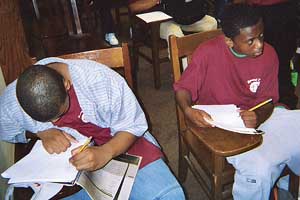 Two teen-age boys study in a summer class offered through the Office of Special Programs/College Prep. | |
“Our largest outreach program is the Center for Urban School Improvement. USI founded and continues to run the North Kenwood-Oakland Charter School, which serves preschool through 8th-grade students, predominantly low-income and very similar to the makeup of most Chicago public schools. NKO has been created to be a professional development school for the public school community of Chicago in order to enhance teaching practices throughout the city,” Richardson said. “The USI is working very closely as well with the current CPS administration as it aims to improve dramatically the public schooling opportunities for citizens of the mid-South Side.”
NKO, which was founded in 1998, is the outgrowth of initiatives by its founding director Anthony Bryk, the Marshall Field IV Professor in Sociology. USI is now directed by Timothy Knowles, former deputy superintendent for the Boston Public Schools.
With a gift from the Crown Foundation, the University also extends its resources to Chicago Public School students through the Collegiate Scholars Program (http://chronicle.uchicago.edu/040527/collegiate-scholars.shtml). Now in its second year, the program enables admitted CPS students to take classes with some of the University’s most distinguished faculty members on a range of topics. Out of 600 applicants in the 2003-04 academic year, 55 were admitted to the program.
A new philosophy of outreach
The Division of the Humanities’ major program has its own theory of outreach. The Civic Knowledge Project, run by Danielle Allen, Dean of the Division of the Humanities, sees the University as just one “knowledge community” among others.
Working from a new view of the social effects of education, the project directors argue that it is wrong to assume knowledge is not powerful in and of itself and that it merely gains social power by helping people act in ways that affect their social and economic status. Instead, the directors state: “We consider knowledge and its circulation to have structural social effects” that are as fundamental as “brute economic realities.” Increasing knowledge circulation around the University does not just empower local communities, but also it establishes the University as a community resource.
“The model for this kind of project has always been the client-provider model,” said Allen. But she argues that knowledge flows both ways. “We believe the community can build the University’s intellectual capital and that the University can help build the community’s intellectual capital. All of our programs are oriented toward that work.”
These programs include the Odyssey Project, co-funded and co-organized with the Illinois Humanities Council, which provides a one-year course in the humanities for adults at or below the poverty level. It provides students with access to higher education and a springboard to further academic opportunities.
Because these adult students may have children whose futures also are at stake, the project recently partnered with neighborhood schools to provide tutoring for these children. While providing childcare, students from the College help the kids with educational homework and games. Childcare “further enhances the project because adults don’t need to worry that their children are falling behind,” said associate director Elizabeth Babcock. Mario Santana, Professor in Romance Languages & Literatures, has led the pilot of a Spanish version in the Pilsen neighborhood.
In the Reading Your Rights Project at the William Carter School, graduate students tutor sixth- and seventh-graders in reading, while incorporating voting and civil rights content into the curriculum.
The Washington Park Knowledge Project takes its goals outside of school, aiming to “develop Washington Park as a space for the interchange of knowledge between the University and members of the community.” The project institutes programming to interest both the University and the community in their shared history.
Enhancing Assets: Small Humanities and Arts Institutions Resource Network will map all South-Side humanities and arts institutions into a database, provide public access to them, and then provide a place for the smaller institutions to connect with each other and discuss the business challenges for humanities and arts organizations.
One South-Side arts institution, the Smart Museum of Art, offers education programming for local families, educators and students. For instance, the Smart organizes Art Afternoons every week in the summer and offers Family Days three times a year, at which families can make art and tour the galleries together.
The museum also partners with 20 to 25 Chicago Public Schools to integrate museum resources into area classrooms. For teachers, the museum leads professional development classes, such as the Saturday, Oct. 9 workshop that will help teachers integrate the study of the current exhibition, “Between Past and Future: New Photography and Video from China,” into their curricula. In addition, the Smart’s programs for children, primarily those in South-Side public schools, offer students tools to learn through and about art. For example, the Art in Focus program introduces third- and fourth-graders to different processes of looking at and making art, using the interactive website, http://smartmuseum.uchicago.edu/smartkids/index.html, and the Smart’s collection.
Examining racial identity, exploring ancient cultures
South-Side residents and students are not only building and utilizing arts and humanities resources, but they also are investigating the places where culture meets politics—and making their own movie about it.
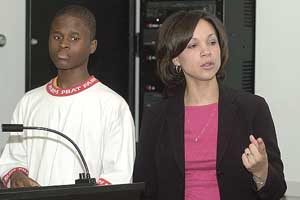 Melissa Harris-Lacewell, Assistant Professor in Political Science (at right, above) takes questions following the May screening of Blackness: A Representation, a film produced by high school students who attend Kenwood Academy. 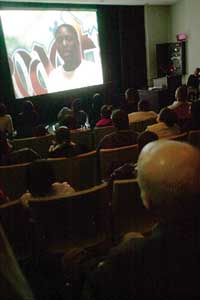 | |
As part of the five-year-old Program for Academic Exploration for High School Juniors and Seniors, the Center for the Study of Race, Politics and Culture, supported by the University’s Neighborhood Schools Program, led a group of Kenwood Academy students earlier this year through an enrichment program titled “Race and Representation.”
The students began their work on the cooperative effort in late January with the goal of defining the topic of race. They then met with Melissa Harris-Lacewell, Assistant Professor in Political Science, who organized coursework with Jacqueline Stewart, Associate Professor in English Language & Literature and the Committee on Cinema and Media Studies.
“We developed a conversation about the multiple meanings of racial representation,” Harris-Lacewell said. “We investigated representation both as a political idea and as a cultural idea.”
The students visited the Smart Museum of Art to discuss visual art as they worked toward understanding visual art representation. The students also listened to guest speakers and visited the Chicago City Council to talk with aldermen about representing African-American and Latino constituents.
The students’ work culminated with the production of a documentary film, Blackness: A Representation, which includes interviews with high school students and other Chicagoans about the meanings of racial identity. The film was presented in May in Cobb Hall as part of the concluding activities of the program.
Richardson said Harris-Lacewell’s work is a perfect example of faculty outreach that flows from research. “Her work with adolescents should not be seen as totally separate from her work in Political Science, because her research provides a way of understanding the sophisticated political dimensions of black culture in cities, an understanding that ‘Race and Representation’ also helps foster.”
An interest in understanding the places from which individuals are separated, both by distance and time, reached peak levels this year, according to the Museum Education Program in the Oriental Institute. The institute’s programming reached nearly 12,500 people last year, a number that doubled compared to the previous year, and which reflects interest in the new Edgar and Deborah Jannotta Mesopotamian Gallery. The gallery opened at a time of heavy engagement for the United States in Iraq.
“This dramatic increase was the largest of any year over the past decade. Opening the new gallery allowed us to share the treasures of our collection at a time when the public began seeking increased understanding of the Middle East,” said Carole Krucoff, Head of Museum Education.
Museum education staff organized events in October 2003 in conjunction with the opening of the gallery, including opportunities to learn about crafts from the area, using processes developed in ancient times. Families also had opportunities to play ancient board games and create their own versions of some of the artifacts on display in the gallery.
With a grant from the Lloyd A. Fry Foundation, the museum education program organized a summer seminar series for teachers on ancient Mesopotamia. Teachers visited the museum, attended faculty lectures, and learned about electronic and other resources available for teaching lessons on Mesopotamia.
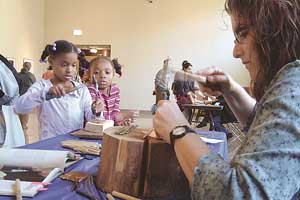 Metalsmith Pam Robinson (at right) of the Lill Street Art Center uses ancient-style tools and processes to demonstrate her craft for two young Oriental Institute visitors. 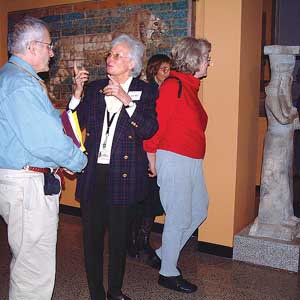 Volunteer docent Anne Schumacher (center) answers a visitor’s question during the grand opening of the Edgar and Deborah Jannotta Mesopotamian Gallery at the Oriental Institute. | |
The museum education program offers adult education courses on campus, at the Gleacher Center and on the Internet. Additionally, it holds a series of “Lunchtime in Another Time” programs that allow people from the campus community and the neighborhood to visit the galleries and take part in special themed tours.
Volunteers and others take programs into the community as well, including the “Be an Ancient Egyptian Artist” program, which is offered at an art center on the North Side during a day camp.
The museum education program also trains teachers through the Museum Partners in Science Program of the Chicago Public Schools. Graduate students show teachers how archaeology draws upon the biological and physical sciences to obtain information about the ancient past.
Educating those who educate and inform
Much of the community outreach work within the Social Sciences Division also focuses on teacher education and public lectures.
In June, for instance, the Center for East Asian Studies, the Center for Latin American Studies, the Center for Middle Eastern Studies, the South Asian Language and Area Center, the Center for International Studies, and the Graham School of General Studies presented “Regional Perspectives on Globalization and Human Rights: A Workshop for Educators.”
Faculty and other researchers presented a session on the environment, looking at China’s Three Gorges Dam project; a session on corporations, looking at the Union Carbide disaster in India; a session on migration related to the Latin American experience; and a session on religion and politics based on research in the Middle East.
In addition to the teacher programs, scholars interested in international affairs often present public lectures on topics related to their work.
The Center for International Studies helped organize a project, the World Beyond the Headlines series (http://chronicle.uchicago.edu/040429/lectureseries.shtml), presented in collaboration with the Chicago Council on Foreign Relations, the International House Global Voices Program and the student-run Chicago Society. The series, held from January through May, provided a forum for scholars and journalists to discuss international issues and the ways in which those issues are presented in the U.S. media.
The Center for Latin American Studies offers workshops designed by University faculty, graduate students and staff to enhance the classroom curricula of educators from high schools and community colleges on subjects not traditionally taught in the U.S. school system. From October through May 2005, for instance, the center will offer a course on the topic of social change in Latin American cinema.
“Teacher training is one way that we deliver our center’s outreach objective of sharing University resources with business, government, education, media and the general public,” said Patrick Eccles, Outreach Coordinator at CLAS. “We appreciate doing this kind of outreach because we believe it generates greater interest and informed discussion of Latin America in an everyday fashion—at school, on the job and in basic conversation. We know that participants enjoy our courses, not just from the evaluations but also because so many of our attendees keep returning year after year.”
Other examples of outreach activities by the area centers include:
The Center for East Asian Studies provided seven guest instructors from the University for a program, offered this summer by North Central College in Naperville, which was designed to prepare K-12 teachers for teaching East Asian studies in their classrooms.
The Center for East European and Russian/Eurasian Studies operates a speakers’ bureau, through which a select group of graduate students share their knowledge of Russia, Eastern Europe, Central Asia and the Caucasus with the Chicago-area community.
In addition to offering K-12 teacher workshops and a speakers bureau, the Center for Middle Eastern Studies organizes curriculum workshops for post-secondary level educators, including its new week-long Summer Institute for Faculty, which resulted in the production of a packet of resources for teachers to use in the classroom.
The South Asia Language and Area Center (http://chronicle.uchicago.edu/030515/south-asia.shtml) operates a lending library of videotapes and books to expand the resources of teachers interested in including information about South Asia in their classes.
Mentoring children with hands-on science projects
One of the University’s newest outreach efforts is the Science and Technology Outreach Mentoring Program. The Office of the Vice President for Research and for Argonne National Laboratory initiated the program earlier this year in the North Kenwood-Oakland Charter School.
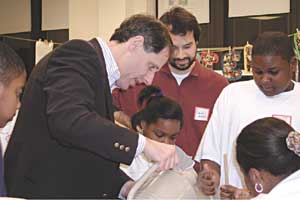 Thomas Rosenbaum (above in foreground), Vice President for Research and Argonne National Laboratory and the James Franck Professor in Physics and the College, conducts an experiment with students at the North Kenwood-Oakland Charter School as part of the Science and Technology Outreach Mentoring Program offered through his office. | |
“What we wanted to do was instill in very young children the culture of science and the fact that science is fun and hands-on,” said Diana Jergovic, Director of Finance and Research Development for the Office of the Vice President for Research, who heads the program.
After-school clubs are a major component of this mentoring outreach program, with one club serving first through fourth grades and the other serving the fifth through eighth grades. Last year, each club had approximately 15 participating students.
Postdoctoral researchers and graduate students from the divisions of the Biological Sciences and the Physical Sciences served as club leaders, as did members of the outreach team of the University’s Materials Research Science and Engineering Center and undergraduates in the College. The club leaders guided the grade-school students through two 10-week curriculums designed to augment their classroom work.
The Office of the Vice President for Research also participates in the annual Hispanic Youth Symposium sponsored by the Idaho National Engineering and Environmental Laboratory. The University’s interest in the event stems from its operational ties to Argonne National Laboratory-West in Idaho. The symposium encourages Latinos to pursue a college education and consider majoring in the sciences.
Another relatively new outreach program is called SciTech/Chicago Outreach Pilot Exploration, or SCOPE, which teaches graduate students at the University and elsewhere about the presentation of modern science to a broad public.
The program began in 2002, with seed money from the University’s Kavli Institute for Cosmological Physics and the Materials Research and Engineering Center. It continues with funding from the National Science Foundation, the Physical Sciences Division Dean’s Office, and the Office of the Vice President for Research and for Argonne National Laboratory.
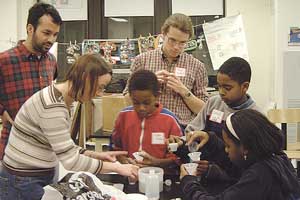 Graduate students affiliated with the Materials Science Research and Engineering Center perform experiments on granular materials with students in the science club of the North Kenwood-Oakland Charter School. Pictured (from left) are Carlos Ancona Torres, Klara Elteto and Mike Seifert. | |
During the last academic year, 13 Chicago graduate students in Anthropology, Physics and Computer Science and students from other institutions developed exhibits in materials science and astronomy for the SciTech Hands-On Museum in Aurora, Ill.
The materials science exhibition, “Sands of Time,” includes three exhibits illustrating the concepts of granular materials developed by Chicago’s material lab.
The astronomy exhibition is a three-dimensional interactive, electronic display based on new data from the Sloan Digital Sky Survey, a collaboration involving the University and other institutions to map the galaxies of the universe in three dimensions. Museum visitors can virtually tour the Sloan Digital Sky Survey Telescope at Apache Point, N.M., to get a feel for the human scale of the project. Then they can fly through the universe, drawing upon the massive Sloan Digital Sky Survey database, to see how galaxies are distributed in clusters that form large structures spread throughout space. Both the electronic and the materials exhibits have been added to the permanent display at SciTech, and will form the basis for part of the work of next year’s intern group.
Although not officially part of SCOPE, one outgrowth of the program includes an ongoing effort involving the University’s Department of Astronomy & Astrophysics to develop similar interactive electronic exhibitions at the Adler Planetarium and Astronomy Museum in Chicago.
Richardson explained how innovative and effective outreach can arise from individuals, as well as programs, by pointing to Don York, the Horace B. Horton Professor in Astronomy & Astrophysics and the College. “York understood the centrality of technology because of his own research, and he also understood its power to engage young people. He also understood it was a tremendous disadvantage to public school students to graduate with little technology background. So he started this crusade to make technology an important teaching and learning tool in the classrooms of CPS.”
The Chicago Public Schools/University of Chicago Internet Project York established in 1996 continues to enhance teaching and learning in 26 public schools within a two-mile radius of the University’s campus. Over the years, CUIP has worked on-site in schools with principals, technology coordinators and hundreds of teachers (http://chronicle.uchicago.edu/040219/cuip.shtml).
In May, CUIP held its third annual Tech Expo at King College Prep High School.
“The Expo marks the culmination of our efforts to improve the use of computers and the Internet as tools for teaching and learning,” said CUIP Managing Director Benjamin Lorch.
The event attracted 600 public school students and 100 teachers, administrators and visitors. Staging the event was an intensive effort, involving assistance from 22 students in the Neighborhood Schools Program of the University’s Office of Community and Government Affairs and the 10-member CUIP staff. The Neighborhood Schools Program, co-founded and directed by Richardson, brings 450 University students to work in 26 CPS schools.
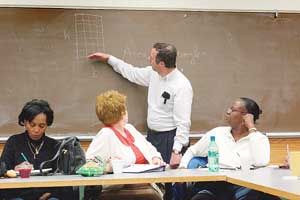 Robert Fefferman, Dean of the Physical Sciences Division and the Max Mason Distinguished Service Professor in Mathematics and the College, instructs teachers from the Chicago Public Schools in Mathachievement, another teacher development program that was offered through the University. | |
Other outreach efforts within the Physical Sciences Division include:
Project Exploration makes science accessible to the public, with a special focus on urban children and girls (http://chronicle.uchicago.edu/040304/dino.shtml).
The Materials Research Science and Engineering Center will begin a new initiative this fall geared toward middle- and high-school Latina girls, in collaboration with a Latino neighborhood.
Seminars for Elementary Specialists and Mathematics Educators, or SESAME (http://chronicle.uchicago.edu/000302/sesame.shtml), was founded in 1991 by Paul Sally Jr., Professor in Mathematics, and is a staff development program in mathematics and science leading to state endorsement. Sally also directs the Young Scholars Program, an intensive summer and academic-year program for mathematically talented students in grades 7 through 12.
The Summer Institute for the Development of Mathematics Teachers in Chicago Middle Schools (http://chronicle.uchicago.edu/990923/math.shtml) enrolled more than 125 teachers from Chicago Public Schools this summer. The program is funded by the Polk Bros. Foundation and led by Robert Fefferman, Dean of the Physical Sciences Division and the Max Mason Distinguished Service Professor in Mathematics and the College.
Izaak Wirszup, Professor Emeritus in Mathematics and the College, founded the University of Chicago School Mathematics Project (http://chronicle.uchicago.edu/031120/math.shtml) in 1983. The project works to upgrade mathematics education in U.S. elementary and secondary schools.
The Center for Elementary Mathematics and Science Education (http://chronicle.uchicago.edu/030417/mathcenter.shtml) was established in 2003, with royalties generated by Everyday Mathematics, a K-6 curriculum first developed at the University.
The Space Explorers (http://chronicle.uchicago.edu/990812/explorers.shtml), an education and outreach program of the Kavli Institute, is a multi-year commitment to local inner-city middle- and high-school students that seeks to help them succeed in high school, college and beyond in science, math, engineering and technology. Of the first three cohorts of KICP-mentored seniors, 100 percent have graduated, 100 percent have gone on to college and over half are science, math, engineering or technology majors.
 Members of the Space Explorers recreate the radio astronomy experiment that in 1965 led to the discovery of the cosmic microwave background radiation, the afterglow of the big bang. The scientists who conducted the original experiment received the Nobel Prize in Physics in 1978. The Space Explorers, an education and outreach program of the Kavli Institute for Cosmological Physics, aims to increase interest and abilities in math and science of African-American students from disadvantaged inner-city schools. Space Explorers who graduated in 2003 have enrolled at Chicago as well as at other colleges and universities. | |
Biological Sciences Collegiate Division puts learning under the microscope
A variety of Biological Sciences Collegiate Division outreach programs are conducted with funding from the Howard Hughes Medical Institute. José Quintans, Professor in Pathology and Associate Dean and Master of the Biological Sciences Collegiate Division, has provided access to special University faculty seminars and laboratory experiences in science topics for teachers and high school students in the Chicago Public Schools.
“The BSCD is committed to sharing its cutting-edge educational programs with others,” Quintans said. “Over the years, the HHMI-funded outreach programs have helped us achieve our goals to extend exceptional educational programs to the community. We are proud of our efforts and accomplishments.”
These programs include the Summer Biology Seminar and mini-lab grants for high school teachers; Saturday Seminars in Biology for high school teachers and students; the Research in the Biological Sciences program; the Science Teachers Exchange Program; the High School AP Biology Laboratory Program; summer research internships for high school students; and the Biological Sciences Collegiate Division loan library of lab equipment available to high school teachers.
Research in the Biological Sciences is a summer program for high school students offered by the BSCD and the Graham School of General Studies. The four-week intensive training program exposes students to a broad range of molecular, microbiological and cellular biological techniques currently used in research laboratories.
Now in its fourth year, RIBS leads a project on RNA interference in the C. elegans, a tiny worm that displays biological characteristics that researchers can exploit in the study of human biology. RIBS students clone several genes from C. elegans and use RNA interference to disrupt expression of these genes and see how this changes the physical characteristics of the worms.
Additionally, new programs targeting clergy and journalists have been established in the division, including a genetics course developed in collaboration with the Chicago Theological Seminary. The workshop, titled God, Adam and Eve: Theological Anthropology in the Genome Age, is offered periodically, and members of the faculty from the University and the seminary jointly teach the workshop.
The educational workshop Stem Cells for Journalists was designed to educate those working in media organizations across the globe. Journalists are exposed to the science surrounding controversial stem cell research.
School reform and community development is the mission
While medical ethics and advances in medicine are explored in the biological sciences at the center of campus, south of the Midway Plaisance the University’s School of Social Service Administration extends its mission to foster excellence in public service with its neighbors.
In the Grand Crossing neighborhood south of the University, SSA has been involved in a project at Revere School.
“Several of our staff and faculty have provided technical assistance in the redevelopment of the area, providing input on issues related to housing development, community development, school social work and youth development,” said Jamie Stanesa, Associate Dean for Programs in SSA.
SSA expects to place seven students in field placements this fall at Revere, which is involved in a comprehensive school reform development effort with support from the Comer Science and Education Foundation.
Additionally, SSA has worked with the Community Outreach Partnership Center, a three-year effort financed by a grant from the Department of Housing and Urban Development. In the project, SSA has provided technical assistance as well as free enrollment in its professional development programs to social-service professionals serving neighborhoods south of the University.
Seeking justice in the public interest
While SSA students and faculty reach out to their neighbors, their neighbors to the east—numerous law faculty and students—seek to protect the legal rights of citizens in their pursuit of justice throughout the city of Chicago.
The Law School’s three distinguished legal clinics (http://chronicle.uchicago.edu/011129/lawclinics.shtml), the Mandel Legal Aid Clinic, the MacArthur Justice Center and the Institute for Justice Clinic on Entrepreneurship, are well established. Together, the clinics handle approximately 222 cases each year. The Mandel Legal Aid Clinic, founded by Edward Levi, former Law School Dean and President of the University, has initiatives in criminal and juvenile justice, employment discrimination, housing, mental health, police accountability, and social service. The MacArthur Justice Center focuses on human rights and social justice issues through litigation, while the Institute for Justice Clinic on Entrepreneurship helps entry-level business people with legal advice to start and maintain their companies.
Law students assist faculty in the clinic cases, and they also have created their own organizations that support public service.
“We’ve found that Chicago students are very dedicated to public interest and want to find ways to volunteer or use their legal skills to help the less fortunate,” said second-year law student Elizabeth Cook, Vice President of PILS (Public Interest Law Society).
“This coming year, PILS will be especially focused on reaching out to first-year law students, who often have a great deal of enthusiasm but little time or expertise.”
Last year, PILS introduced a new community action-mentoring program, matching first-year law students with upper-class students and professors on social justice projects, including issues on the death penalty, immigration and Native-American rights.
Cook said the initiative was enthusiastically received, and many more students applied than could be accommodated. In the upcoming academic year, PILS plans to pair students with legal aid agencies in Chicago that need help with client intake.
The group FeedChicago tries to hold one fund-raising event each quarter to feed the homeless, including a casino night at the Law School in the fall and an interclass competitive food drive in the winter. “Our first year, the casino night raised about $600, and this past year we raised almost $850,” Kamienski said. “Each dollar we raise can provide four meals. So many law students have families or jobs and can’t commit to tutoring or volunteering for several hours each week, but they still want to give back to the community. Our goal has been to provide a meaningful opportunity for service that would not require a burdensome time commitment.”
StreetLaw is a law student initiative that organizes volunteers into teaching teams, which lead a class once a week in area high schools. “Each team tailors its class specifically to the particular school in which they’re teaching,” said Sheila Kadagathur, a third-year law student who ran the program last year with Law School third-year Felicia Ellsworth.
Other student-sponsored organizations include the Environmental Law Society, which sponsors an environmental law clinic and programs on environmental protection issues; the International Human Rights Society, which teaches students about human rights law and affords them the opportunity to practice in this specific legal area; and Neighbors (http://chronicle.uchicago.edu/940331/neighbors.shtml), the student-run group that organizes volunteering in the local community.
“A University of Chicago legal education is an investment not only in a student’s future, but also in quality legal service and leadership in the larger community,” said Eleanor Arnold, Dean of Students in the Law School. “Law School students begin their process of professional development for their legal careers, and many of them aspire to draw on their skills and insights for the public good.”
Going ‘public’ with community and economic policies
At the Irving B. Harris Graduate School of Public Policy Studies, Master of Public Policy candidates can choose from a range of student-led programs that have community outreach components.
The Community and Economic Development Organization, a collaborative, student-led venture between SSA and the Harris School, sponsors activities that promote community awareness, foster sustainability and improve the quality of life in lower-income neighborhoods that lack basic services.
“Our vision is clear,” said CEDO leader Janelle George, an M.P.P. candidate, who holds an M.S.W. “We begin by putting the ‘service’ back into social service and going ‘public’ with community and economic policies that impact underserved families and communities. We strive to achieve this through an array of volunteer opportunities, speaker-forum events and learning partnerships with local initiatives,” George explained.
“Minorities in Public Policy Studies promotes critical discourse to recognize complex social, political, economic and cultural issues that face all minorities today,” said Harris M.P.P. candidate Michelle Garcia. She described the organization as “a much needed forum in the Harris School to discuss policy issues and how people’s lives are impacted by policy in ways not always found in the classroom.”
The organization also works to increase the number of minorities attending the school and promotes civic participation.
The Public Policy Student Association “serves as an advocate to communicate student concerns to the faculty and administration.” Member and Harris M.P.P. candidate Arik De said the association’s recent focus has been on community service activities that engage the local community. “Our belief is that as the student government group in a policy school, we can offer our colleagues their first platform to move into a committed future as public servants,” said De.
The one-year-old Women in Public Policy organization was formed to increase awareness of gender issues in public policy decision-making. A member of the organization and a Harris M.P.P. candidate, Kelly Smith said the new organization “is off the ground, and we’re really hoping to become more active in the community through our advocacy and service learning committees.”
Graduate School of Business students are Giving Something Back
Students in the Graduate School of Business created Giving Something Back, which offers a variety of programs that students and faculty have engaged in throughout Hyde Park. The GSB programs range in focus from educational tutoring to assistance for the homeless to fund-raising for selected local and national charities.
Falling under its educational programs are the Ray School tutoring program for students in grades four through six at Ray Elementary School in Hyde Park; Hyde Park scholarships, which provide funds for Hyde Park high school students bound for college; Junior Achievement, which teaches basic business concepts and skills to first- through sixth-graders; and one-on-one GED-preparatory instruction for homeless women and their children.
GSB projects that are designed to support homeless individuals and low-income residents include the annual MBA Food Fight, a good-natured competition among several MBA schools to raise the most money for a local food bank; a holiday Toys-for-Tots collection; and a spring clothing drive in conjunction with career services to benefit the Midwest Workers Association.
GSB volunteers also renovate the homes of the elderly and disabled individuals, help build playgrounds, sponsor an annual blood drive and serve home-cooked meals to families staying at the Ronald McDonald House.
The year is then capped off with the annual GSB Charity Auction held at the Peggy Notebart Nature Museum. The auction raises between $30,000 and $40,000 for two to three student-selected local and national charities, which GSB students and faculty support.
For a more complete listing of outreach programs conducted by the University, visit http://oca.uchicago.edu/workingtogether.
Editor’s note: The entire News Office staff contributed to this story.
![[Chronicle]](/images/sidebar_header_oct06.gif)